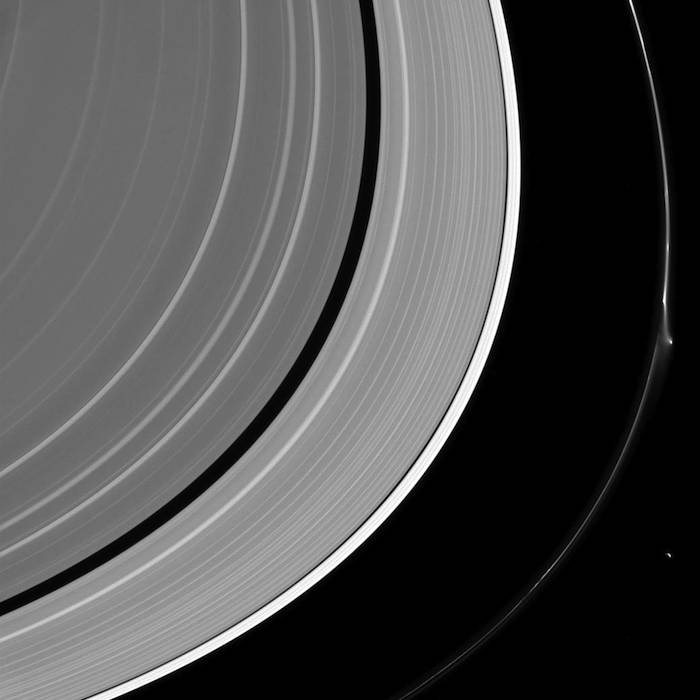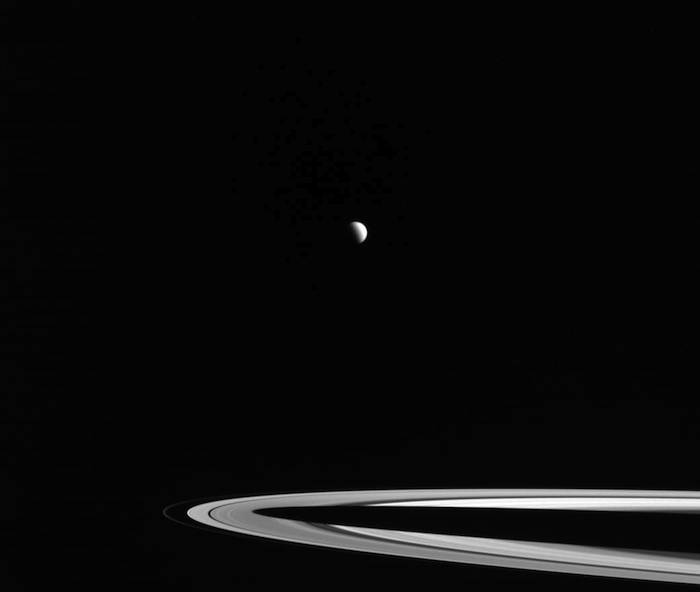.

A bright disruption in Saturn's narrow F ring suggests it may have been disturbed recently. This feature was mostly likely not caused by Pandora (50 miles or 81 kilometers across) which lurks nearby, at lower right. More likely, it was created by the interaction of a small object embedded in the ring itself and material in the core of the ring. Scientists sometimes refer to these features as "jets."
Because these bodies are small and embedded in the F ring itself, they are difficult to spot at the resolution available to NASA's Cassini spacecraft. Instead, their handiwork reveals their presence, and scientists use the Cassini spacecraft to study these stealthy sculptors of the F ring.
This view looks toward the sunlit side of the rings from about 15 above the ring plane. The image was taken in visible light with the Cassini spacecraft narrow-angle camera on April 8, 2016.
The view was acquired at a distance of approximately 1.4 million miles (2.2 million kilometers) from Saturn and at a Sun-Saturn-spacecraft, or phase, angle of 105 degrees. Image scale is 8 miles (13 kilometers) per pixel.
The Cassini mission is a cooperative project of NASA, ESA (the European Space Agency) and the Italian Space Agency. The Jet Propulsion Laboratory, a division of the California Institute of Technology in Pasadena, manages the mission for NASA's Science Mission Directorate, Washington. The Cassini orbiter and its two onboard cameras were designed, developed and assembled at JPL. The imaging operations center is based at the Space Science Institute in Boulder, Colorado.
---
Rings Interrupted

Distant Titan, its northern hemisphere drenched in the sunlight of late spring, hangs above Saturn's rings. What might at first glance look like a gap between the rings and the planet is actually Saturn’s shadow. During most of Saturn's long year, the projection of the planet's shadow extends well beyond the edge of the A ring. But, with summer solstice fast approaching, the Sun is now higher in Saturn's sky and most of Saturn's A ring is completely shadow-free.
This view looks toward the sunlit side of the rings from about 3 degrees above the ring plane. The image was taken in red light with NASA's Cassini spacecraft wide-angle camera on Jan. 26, 2016.
The view was obtained at a distance of approximately 1.8 million miles (2.9 million kilometers) from Titan and at a Sun-Titan-spacecraft, or phase, angle of 84 degrees. Image scale on Titan is 109 miles (176 kilometers) per pixel.
The Cassini mission is a cooperative project of NASA, ESA (the European Space Agency) and the Italian Space Agency. The Jet Propulsion Laboratory, a division of the California Institute of Technology in Pasadena, manages the mission for NASA's Science Mission Directorate, Washington. The Cassini orbiter and its two onboard cameras were designed, developed and assembled at JPL. The imaging operations center is based at the Space Science Institute in Boulder, Colorado.
Quelle: NASA
5104 Views
